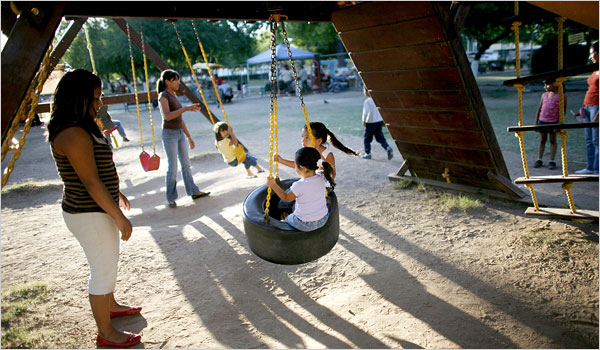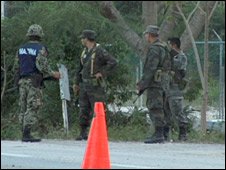- Reaction score
- 28
- Points
- 560
A Cause Célèbre Clouds Mexican Sentiment on Kidnapping Scourge
As Mexican Killings Rise, Groups Take Envoy to Task

Francisco Barrio Terrazas, left.
(Does that mean the newspaper assumed that Americans knows who's right?)
MEXICO CITY — Lawless Ciudad Juárez has become a potent symbol of Mexico’s escalating drug war.
Drug cartels recently chased out the police chief there, and citizens have become fearful witnesses
to daily murders of drug dealers, police officers and bystanders. But lost amid the headlines are
the murders of young women that drew international notice more than a decade ago and that
continue today.
Now, frustrated women’s groups are making new headlines of their own, challenging the recent
appointment of Mexico’s ambassador to Canada, Francisco Barrio Terrazas. They say he was
negligent in dealing with the killings in the 1990s as governor of the state of Chihuahua, where
Ciudad Juárez is located, across the border from El Paso, Tex.
The women’s groups, along with other human rights organizations, sent a formal protest to Mexico’s
Ministry of Foreign Relations this month. They are also asking the Foreign Relations Commission
of the Mexican Senate to reconsider Mr. Barrio Terrazas’ appointment. Several human rights groups
in Quebec have supported their protests.
“He doesn’t represent Mexicans,” said Marisela Ortiz, a founder of May Our Daughters Return Home,
an association of victims’ families in Ciudad Juárez that is leading the challenge. “Because of his
misogynistic characteristics, we oppose him having any position, and even less in a country that
is known as a promoter of peace.”
Rights groups estimate that as many as 500 women have been killed since 1993 in Ciudad Juárez and
other cities in the state of Chihuahua. Many of them were tortured before they were killed, their bodies
often found weeks later, dumped in the desert. Many of the killings remain unsolved. Although several
people have been convicted in some of the slayings over the years, some were later released after
evidence suggested they were tortured into confessing.
Women’s groups have long maintained that the police did not try to solve the cases, either because
they feared that organized crime was involved or because they were involved themselves, or both.
The groups also argue that the authorities simply did not care because the victims were poor. Many
of those killed had challenged Mexico’s machismo culture by earning their own livings in the area’s
assembly plants. The women’s groups’ most incendiary assertion against Mr. Barrio Terrazas — and
one that the Mexican media have repeated — is that he once suggested that the victims should not
have worn miniskirts and walked through unlighted streets. But it is unclear whether Mr. Barrio
Terrazas, who was governor for six years starting in 1992, ever made such a statement.
In response to a query, the Mexican Embassy in Ottawa said the ambassador “rejects the notion that
he was indifferent or insensitive about the topic or that he insinuated that the murdered women
of Ciudad Juárez, Chihuahua, bore some responsibility for their own deaths.” The embassy statement
also said he had “strongly encouraged the punishment of the perpetrators of murders or
disappearances of women.”
Mr. Barrio Terrazas, a member of President Felipe Calderón’s National Action Party, has held several
national posts since his years as governor, including serving as a deputy in the Mexican Congress.
He began work as ambassador on Feb. 26, after Senate ratification.
As violence in Juárez has risen in the past year, so, too, have the killings of women, said Ms. Ortiz,
of May Our Daughters Return Home. The state government said that 98 women were killed last year
in Juárez, although Ms. Ortiz estimated the toll at 130.
Although attention in Mexico to the plight of the women of Juárez has wavered, the murders have
caught the attention of celebrities. The latest to take up the cause is the singer Peter Gabriel who,
along with representatives of human rights groups, met with Mr. Calderón last month to deliver a
petition asking him to work to end violence against women.
As Mexican Killings Rise, Groups Take Envoy to Task

Francisco Barrio Terrazas, left.
(Does that mean the newspaper assumed that Americans knows who's right?)
MEXICO CITY — Lawless Ciudad Juárez has become a potent symbol of Mexico’s escalating drug war.
Drug cartels recently chased out the police chief there, and citizens have become fearful witnesses
to daily murders of drug dealers, police officers and bystanders. But lost amid the headlines are
the murders of young women that drew international notice more than a decade ago and that
continue today.
Now, frustrated women’s groups are making new headlines of their own, challenging the recent
appointment of Mexico’s ambassador to Canada, Francisco Barrio Terrazas. They say he was
negligent in dealing with the killings in the 1990s as governor of the state of Chihuahua, where
Ciudad Juárez is located, across the border from El Paso, Tex.
The women’s groups, along with other human rights organizations, sent a formal protest to Mexico’s
Ministry of Foreign Relations this month. They are also asking the Foreign Relations Commission
of the Mexican Senate to reconsider Mr. Barrio Terrazas’ appointment. Several human rights groups
in Quebec have supported their protests.
“He doesn’t represent Mexicans,” said Marisela Ortiz, a founder of May Our Daughters Return Home,
an association of victims’ families in Ciudad Juárez that is leading the challenge. “Because of his
misogynistic characteristics, we oppose him having any position, and even less in a country that
is known as a promoter of peace.”
Rights groups estimate that as many as 500 women have been killed since 1993 in Ciudad Juárez and
other cities in the state of Chihuahua. Many of them were tortured before they were killed, their bodies
often found weeks later, dumped in the desert. Many of the killings remain unsolved. Although several
people have been convicted in some of the slayings over the years, some were later released after
evidence suggested they were tortured into confessing.
Women’s groups have long maintained that the police did not try to solve the cases, either because
they feared that organized crime was involved or because they were involved themselves, or both.
The groups also argue that the authorities simply did not care because the victims were poor. Many
of those killed had challenged Mexico’s machismo culture by earning their own livings in the area’s
assembly plants. The women’s groups’ most incendiary assertion against Mr. Barrio Terrazas — and
one that the Mexican media have repeated — is that he once suggested that the victims should not
have worn miniskirts and walked through unlighted streets. But it is unclear whether Mr. Barrio
Terrazas, who was governor for six years starting in 1992, ever made such a statement.
In response to a query, the Mexican Embassy in Ottawa said the ambassador “rejects the notion that
he was indifferent or insensitive about the topic or that he insinuated that the murdered women
of Ciudad Juárez, Chihuahua, bore some responsibility for their own deaths.” The embassy statement
also said he had “strongly encouraged the punishment of the perpetrators of murders or
disappearances of women.”
Mr. Barrio Terrazas, a member of President Felipe Calderón’s National Action Party, has held several
national posts since his years as governor, including serving as a deputy in the Mexican Congress.
He began work as ambassador on Feb. 26, after Senate ratification.
As violence in Juárez has risen in the past year, so, too, have the killings of women, said Ms. Ortiz,
of May Our Daughters Return Home. The state government said that 98 women were killed last year
in Juárez, although Ms. Ortiz estimated the toll at 130.
Although attention in Mexico to the plight of the women of Juárez has wavered, the murders have
caught the attention of celebrities. The latest to take up the cause is the singer Peter Gabriel who,
along with representatives of human rights groups, met with Mr. Calderón last month to deliver a
petition asking him to work to end violence against women.





















